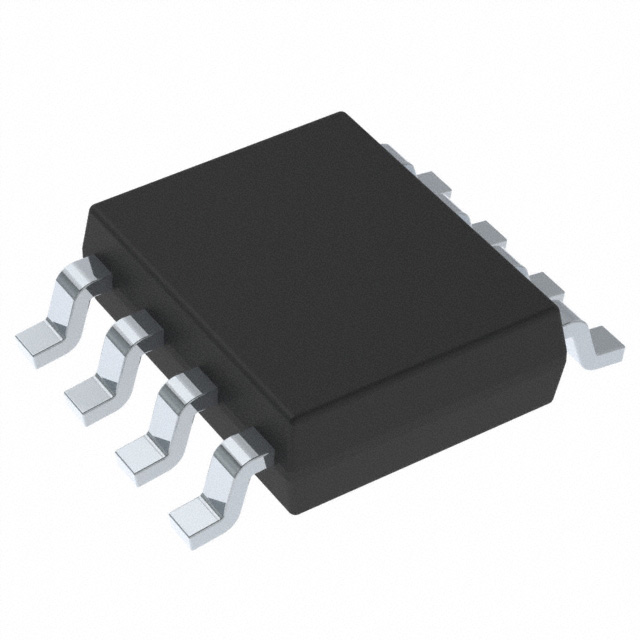Using TPS5430DDAR in Your Electronic Projects

Effective power management is essential for the success of your electronic projects, ensuring that devices function smoothly and reliably. The TPS5430DDAR Voltage Regulator, Step-Down DC-DC Converter, provides an outstanding solution for these requirements. With an energy efficiency reaching up to 95%, it significantly reduces power loss and boosts system performance. This device is especially advantageous for battery-powered gadgets, as it decreases heat production and prolongs battery life. For more comprehensive specifications, please refer to the datasheet.
General Specifications and Features
Overview of TPS5430DDAR Voltage Regulator, Step-Down DC-DC Converter
The TPS5430DDAR Voltage Regulator, Step-Down DC-DC Converter stands out as a powerful solution for managing power in electronic circuits. This device integrates a low-resistance, high-side N-channel MOSFET, which ensures efficient voltage reduction. You will find it particularly useful in applications that demand stable power supply, such as microcontrollers and precision electronics.
Key Features
High Efficiency: Achieves up to 95% energy efficiency, minimizing power loss and heat generation.
Wide Input Voltage Range: Supports 5.5V to 36V, making it versatile for various applications.
Adjustable Output Voltage: Offers flexibility with an output range from 1.22V to 33V.
High Output Current: Delivers a continuous 3A output current, suitable for demanding applications.
Protection Features: Includes overcurrent limiting, overvoltage protection, and thermal shutdown for enhanced reliability.
Benefits of Using TPS5430DDAR
Using the TPS5430DDAR Voltage Regulator, Step-Down DC-DC Converter in your projects brings several advantages. Its high efficiency reduces energy consumption, which is crucial for battery-powered devices. The wide input voltage range allows you to use it in diverse environments, while the adjustable output voltage provides the flexibility needed for different circuit requirements. Additionally, the built-in protection features ensure your devices remain safe under various operating conditions.
Technical Specifications
Input Voltage Range
The TPS5430DDAR Voltage Regulator, Step-Down DC-DC Converter supports an input voltage range from 5.5V to 36V. This broad range allows you to use it in numerous applications, from consumer electronics to industrial systems. You can rely on this device to handle varying input conditions without compromising performance.
Output Voltage and Current
This converter provides an adjustable output voltage from 1.22V to 33V, catering to a wide array of electronic needs. It delivers a continuous output current of up to 3A, making it suitable for high-performance applications. Whether you are powering microcontrollers or other digital devices, the TPS5430DDAR Voltage Regulator, Step-Down DC-DC Converter ensures stable and reliable power delivery.
Pin Layout and Configuration
Understanding the pin layout and configuration of the TPS5430DDAR is crucial for integrating it into your electronic projects. This section will guide you through the pin functions and provide guidelines for effective configuration.
Pin Description
The TPS5430DDAR comes in an SOIC-8-EP package, featuring eight pins, each with a specific role. Knowing these roles ensures optimal performance and prevents potential issues.
Pin Functions
VIN: This pin serves as the power supply input. Connect it to the input voltage source.
GND: The ground connection pin. It acts as the reference point for the circuit.
SW: This pin connects to the inductor and is part of the switching node.
BOOT: Provides the gate drive voltage for the high-side MOSFET.
EN: The enable pin. Use it to turn the device on or off.
COMP: Connect this pin to the compensation network for stability.
FB: The feedback pin. It monitors the output voltage for regulation.
RT/CLK: Sets the switching frequency or synchronizes it with an external clock.
Pin Configuration Guidelines
Ensure all connections are secure and follow the datasheet recommendations.
Use short and wide traces for power and ground connections to minimize resistance.
Place decoupling capacitors close to the VIN and GND pins to reduce noise.
Follow the manufacturer's guidelines for thermal management to prevent overheating.
Schematic Design
Designing a schematic with the TPS5430DDAR involves careful planning and adherence to best practices.
Designing with TPS5430DDAR
Start by placing the TPS5430DDAR at the center of your schematic.
Connect the VIN pin to your power source and the GND pin to the ground plane.
Use an inductor and capacitor network connected to the SW pin for output filtering.
Implement a feedback loop using resistors connected to the FB pin to set the desired output voltage.
Layout Considerations
Position the TPS5430DDAR close to the load to minimize voltage drop.
Keep the feedback trace short and away from noisy signals to ensure accurate voltage regulation.
Use a solid ground plane to improve thermal performance and reduce electromagnetic interference.
Consider the use of vias for heat dissipation, especially under the exposed pad of the package.
By following these guidelines, you can effectively integrate the TPS5430DDAR into your projects, ensuring reliable and efficient power management.
Electrical Characteristics
Understanding the electrical characteristics of the TPS5430DDAR is crucial for optimizing its performance in your projects. This section will guide you through the key performance parameters and operating conditions.
Performance Parameters
Efficiency
Efficiency plays a vital role in power management. The TPS5430DDAR achieves up to 95% efficiency, which means it converts most of the input power into usable output power. This high efficiency reduces energy waste and minimizes heat generation. You can rely on this device to maintain performance while conserving energy, especially in battery-powered applications.
Thermal Performance
Thermal performance is essential for the longevity and reliability of electronic components. The TPS5430DDAR features an SOIC PowerPAD package that aids in heat dissipation. You should ensure proper thermal management by using heat sinks or thermal vias. This approach helps prevent overheating and maintains stable operation under various load conditions.
Operating Conditions
Temperature Range
The TPS5430DDAR operates effectively within a wide temperature range. It functions reliably from -40°C to 125°C. This broad range allows you to use it in diverse environments, from consumer electronics to industrial applications. You should consider ambient temperature and ensure adequate cooling to maintain optimal performance.
Load Conditions
Load conditions impact the performance and stability of the TPS5430DDAR. It supports a continuous output current of up to 3A. You should match the load requirements with the device's capabilities to ensure efficient operation. Monitoring load conditions helps prevent overloading and ensures the longevity of your electronic projects.
By understanding these electrical characteristics, you can effectively utilize the TPS5430DDAR in your projects. This knowledge ensures reliable and efficient power management, enhancing the overall performance of your electronic devices.
Application Fields

The TPS5430DDAR is a versatile component that finds its place in a wide range of applications. Its ability to handle high output currents and provide stable power makes it an ideal choice for various fields.
Common Applications
Consumer Electronics
In consumer electronics, the TPS5430DDAR plays a crucial role. Devices like smartphones, tablets, and laptops require efficient power management to function optimally. The TPS5430DDAR ensures these devices receive stable power, enhancing their performance and longevity. Its high efficiency reduces energy consumption, which is vital for battery-powered gadgets. You can rely on this converter to maintain device functionality while conserving battery life.
Industrial Applications
Industrial systems demand robust and reliable power solutions. The TPS5430DDAR meets these needs with its wide input voltage range and high output current capabilities. It is commonly used in industrial control systems and telecommunications equipment. These applications benefit from the TPS5430DDAR's ability to provide consistent power under varying conditions. By integrating this converter, you ensure your industrial systems operate smoothly and efficiently.
Case Studies
Exploring real-world implementations of the TPS5430DDAR provides valuable insights into its effectiveness and versatility.
Successful Implementations
Automotive Electronics: The TPS5430DDAR has been successfully implemented in automotive electronics. Systems like infotainment units and vehicle-mounted sensors require stable power supplies. The TPS5430DDAR delivers reliable power, ensuring these systems function without interruption. Its protective features safeguard against overvoltage and thermal issues, making it a trusted choice in the automotive industry.
Telecommunications Equipment: In telecommunications, maintaining uninterrupted power is critical. The TPS5430DDAR has been used in various telecommunications equipment, providing stable power and enhancing system reliability. Its adaptability to different voltage requirements makes it suitable for diverse telecom applications.
Lessons Learned
From these implementations, several lessons emerge. First, the importance of proper thermal management cannot be overstated. Ensuring adequate heat dissipation through heat sinks or thermal vias is crucial for maintaining performance. Second, understanding the specific power requirements of your application helps in selecting the right components and configurations. Lastly, always refer to the datasheet for detailed guidelines and specifications to optimize the use of the TPS5430DDAR in your projects.
By leveraging the TPS5430DDAR in your electronic projects, you can achieve efficient and reliable power management across various applications. Its flexibility and protective features make it a valuable asset in both consumer and industrial settings.
Troubleshooting and Best Practices
Potential Failure Modes
Understanding potential failure modes helps you prevent issues in your projects. The TPS5430DDAR, like any electronic component, can encounter problems if not used correctly.
Common Issues
Overheating: Excessive heat can damage the TPS5430DDAR. This often results from inadequate thermal management or excessive load.
Voltage Fluctuations: Unstable input or output voltages can disrupt device performance. This may occur due to incorrect component selection or poor circuit design.
Short Circuits: Improper connections can lead to short circuits, causing device failure.
Diagnostic Techniques
To diagnose issues effectively, follow these techniques:
Visual Inspection: Check for visible signs of damage or poor connections. Look for burnt components or loose wires.
Multimeter Testing: Use a multimeter to measure voltage levels and continuity. Ensure that all readings match the expected values.
Thermal Imaging: Employ a thermal camera to identify hotspots. This helps detect overheating components.
Best Practices for Configuration
Implementing best practices ensures optimal performance and longevity of the TPS5430DDAR in your projects.
Tips for Optimal Performance
Proper Component Selection: Choose components that match the TPS5430DDAR's specifications. This includes selecting appropriate inductors and capacitors.
Efficient Layout Design: Design your PCB layout to minimize trace lengths and reduce electromagnetic interference. Place decoupling capacitors close to the power pins.
Adequate Cooling: Use heat sinks or thermal vias to dissipate heat effectively. This prevents overheating and maintains stable operation.
Maintenance and Monitoring
Regular maintenance and monitoring keep your projects running smoothly.
Routine Checks: Periodically inspect your circuit for signs of wear or damage. Replace any faulty components promptly.
Performance Monitoring: Continuously monitor voltage levels and current flow. This helps detect anomalies early and prevents potential failures.
Firmware Updates: If applicable, update firmware to ensure compatibility and improve functionality.
By following these troubleshooting and best practice guidelines, you can enhance the reliability and efficiency of your electronic projects using the TPS5430DDAR.
The TPS5430DDAR stands out as a crucial component in electronic projects. Its ability to handle input voltages from 5.5V to 36V with high efficiency makes it versatile and reliable. You can benefit from its design-friendly features, which simplify integration into various applications. By exploring the TPS5430DDAR, you unlock opportunities for enhanced power management and device performance. Embrace its potential to elevate your projects, ensuring they operate smoothly and efficiently.
See Also
Efficiently Power Your Car with TPS54260QDGQRQ1
Utilizing HD6477043F28 Microcontroller for Project Success
Assessing ULN2803ADWR's Industrial Performance

